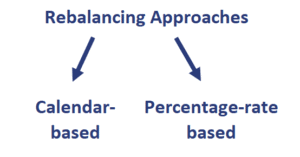Rebalancing Approaches
Portfolio rebalancing approaches are approaches used by investors to adjust their portfolio over time as weights start to deviate from the target weights. Depending on the target portfolio, rebalancing may be needed regularly or not at all. For example, a portfolio that is market-capitalization weighted will need to be rebalanced far less than an equal-weighted portfolio.
On this page, we discuss the two most popular approaches used to rebalance portfolios; calendar rebalancing and percentage-range rebalancing.
Calendar-rebalancing
The first approach we discuss is calendar-rebalancing. As the name suggests, rebalancing is done on a pre-determined, regular basis (e.g. monthly or quarterly). Generally, the frequency depends on the volatility of the portfolio, but sometimes rebalancing is scheduled to coincide with review dates.
The advantage of calendar-rebalancing is that it provides discipline without having to monitor the portfolio all of the time. The disadvantage of the approach is that the portfolio could stray from the target weights considerably between rebalancing dates.
Percentage-rate rebalancing
The second approach is percentage-range rebalancing, sometimes also called range-based rebalancing. Under this approach, investors set tolerance bands or corridors between which the weights are allowed to fluctuate freely. If an asset class wanders outside that corridor, the portfolio needs to be rebalanced.
The advantage of percentage-rate rebalancing is that it minimizes the degree to which asset classes can violate their allocation corridors. The disadvantage is that it can be more costly because constant monitoring is required and it could lead to more trading if the portfolio is volatile.
Summary rebalancing approaches
We discussed two popular rebalancing methods for rebalancing asset portfolios; calendar rebalancing and range-based rebalancing. Both methods are equally popular, with the choice depending on the goals of the investor and whether or not large deviations can be tolerated or not. In the case strict risk management is needed, a range-based approach is preferred.

